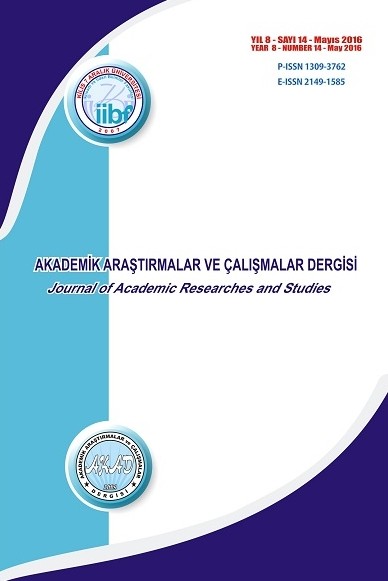TÜRKİYE’DE İSTİHDAMIN SEKTÖREL BELİRLEYİCİLERİ
Bu çalışmada, toplam istihdamın sektörel bazda belirleyicilerini tahmin etmek amacıyla toplam istihdam ile sanayi, inşaat, tarım ve hizmet sektörleri arasındaki nedensellik ilişkisi araştırılmıştır. Çalışmada Bootstrap Rolling Window Nedensellik Testi ile Breitung ve Candelon Frekans Alanı Nedensellik Testi kullanmıştır. Ayrıca çalışmada farklı sektörlerin toplam istihdam arasında anlamlı ilişki bulunmuştur. Sektörler arasında toplam istihdamın temel belirleyici sektörü hizmet sektörü olduğu tespit edilmiştir.
Anahtar Kelimeler:
İstihdam; Breitung ve Candelon Frekans Alanı Nedensellik Testi
___
- Abraham, K.G., Katz, L., 1984. “Cyclical Uneployment: Sectoral Shifts or Aggregate Disturbances?”, National Bureau of Economic Research, No.1410.
- Altuntepe N., Güner T., 2013 Türkiye’de İstihdam-Büyüme İlişkisinin Analizi (1988-2011), Uluslararası Alanya İşletme Fakültesi Dergisi, Yıl:2013, C:5, S:1, s. 73-84.
- Breitung , J., & Candelon, B. (2006). Testing For Short And Long-Run Causality: A Frequency Domain Approach. Journal of Econometrics, 12, 363-378.
- Dickey, D., & Fuller, W. (1979). Distribution of The Estimators For Autoregressive Time Series with a Unit Root.. Journal of The American Statistical Society, 75, 427-431.
- Filiztekin, Alpay, 2005. Bölgesel Gelişme Stratejileri ve Akdeniz Ekonomisi, Erlak H. (Ed.), Bölgesel Büyüme, Eş-Hareketlilik ve Sektörel Yapı, TEK Yayınları, Ankara.
- Fortin, M., Araar, A., 1997. “Sectoral Shifts, Stock Market Dispersion and Unemployment in Canada”, Applied Economics, 29:6, 829-839.
- Geweke, J., 1982, “Measurement of linear dependence and feedback between multiple time series”, Journal of the American Statistical Association 77, 304–313.
- Graff, T., Oort, F.G., Florax, R.J.G.M., 2012. “Sectoral Heterogeneity, Accessibility and Population-Employment Dynamics in Dutch Cities” Journal of Transport Geography, 25, ss:115-127.
- Hosoya, Y., 2001, “Elimination of third-series effect and defining partial measures of causality”, Journal of Time Series Analysis 22, 537–554.
- Kolsuz, G., Yeldan, A.E., 2014. “1980 Sonrası Türkiye Ekonomisinde Büyümenin Kaynaklarının Ayrıştırılması”, Çalışma ve Toplum, 2014/1, Sayı:40.
- Lilien, David, M., 1982. “Sectoral Shifts and Cyclical Unemployment”, Journal of Political Economy, pp. 777-793.
- MacKinnon, James. 1996. “Numerical Distribution Functions For Unit Root and Cointegration Tests” Journal of Applied Econometrics, 11, ss:601–618.
- Mills, T.C., Pelloni, G. Zervoyianni, A., 1995. “Unemployment Fluctuations in The United States: Further Tests of The Sectoral-Shifts Hypothesis”, Rev. Econ. Statist., 77, 294-304.
- Phillips, Peter and Pierre Perron. 1988. “Testing For A Unit Root in Time Series Regressions” Biometrica, 75(2), ss:335-346.
- Robson, Martin, 2006. “Sectoral Shifts, Employment Specialization and The Effiency of Matching: An Analysis Using UK Regional Data” Regional Studies, 40:7, 743-754.
- Sakata, Kei, 2002. “Sectoral Shifts and Cyclical Unemployment in Japan”, Journal of The Japanese and International Economies, 16, 227-252.
- Sakata, K., McKenzie, C., 2004. “The Accumulation of Human Capital and The Sectoral Shifts Hypothesis for Different Age Groups”, Mathematics and Computers in Simulation, 64, 459-465.
- Wei, Yanfeng, 2013. , Doctoral Dissertation, Department of Economics Graduate School of Social Sciences Hiroshima University, Japonya.
- ISSN: 1309-3762
- Yayın Aralığı: Yılda 2 Sayı
- Başlangıç: 2009
- Yayıncı: Kilis 7 Aralık Üniversitesi
Sayıdaki Diğer Makaleler
DOĞRUDAN YABANCI YATIRIMLARIN SOSYO-POLİTİK BELİRLEYİCİLERİ ÜZERİNE BİR ANALİZ
ANA AKIM (ORTODOKS-NEOKLASİK) İKTİSAT ÖĞRETİSİ ELEŞTİRİSİ: HETEREDOKS YAKLAŞIM İHTİYACI
TÜRKİYE’DE İSTİHDAMIN SEKTÖREL BELİRLEYİCİLERİ
Ali TÜFEKÇİ, Süleyman ŞAHİN, Esma GÜLTEKİN, Mehmet TEMİZ
ÜNİVERSİTE ÖĞRENCİLERİNİN CEP TELEFONU TERCİHLERİNİ ETKİLEYEN FAKTÖRLER VE BİR UYGULAMA
ARJANTİN OMBUDSMANI: YAPISAL-KURUMSAL VE İŞLEVSEL YÖNLERİ
TÜRKİYE’DE REEL DÖVİZ KURU VE DIŞ TİCARET İLİŞKİSİNİN VAR ANALİZİ İLE İNCELENMESİ
TEKNOLOJİ VE REKABETÇİLİK: TEMEL KAVRAMLAR VE ENDEKSLER BAĞLAMINDA BİR DEĞERLENDİRME
